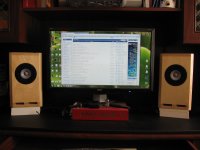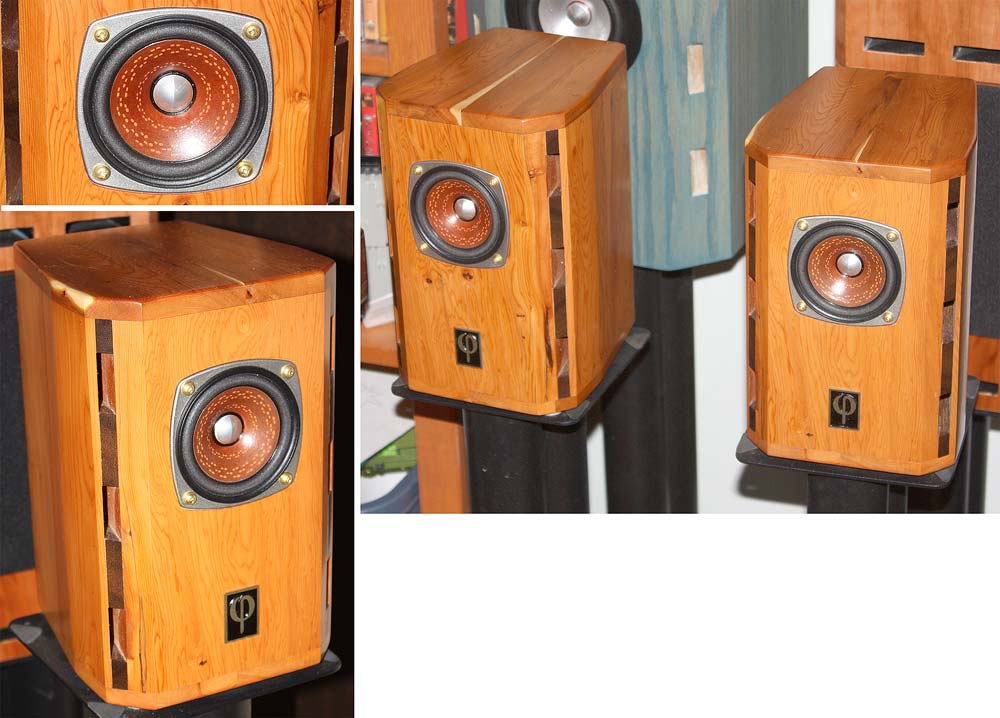Most of the “think-piece” threads on this forum (ideal directivity pattern, uniform pattern, beyond the Ariel, etc.) expressly or impliedly focus on setups in domestic living rooms.
However, many of us enjoy music while sitting at desks with computer screens in front of us. Yet (so far as I could find at least) there wasn't a thread about designing speakers expressly for nearfield/desktop setups. (There are several individual build threads, of course.) The serious literature on preferences in desktop/nearfield loudspeakers is also surprisingly scant, or at least inaccessible. For instance, Dr. Toole’s outstanding lit review, Sound Reproduction, does not have a section about nearfield listening, and for that matter does not even contain the word "desktop!" (The word "desk" appears once, in a § 4.2, "Offices and Industrial Spaces," at 52.)
So, why not start something? Let's proceed from the following five reasonable assumptions:
Two questions:
1) What do you think are desirable traits for loudspeakers expressly designed for nearfield/desktop use?
2) What do you think is the best way to place loudspeakers for nearfield/desktop listening (above the monitor, beside the monitor, flat or toed-in; equilateral triangle or wider/narrower; etc,)?
However, many of us enjoy music while sitting at desks with computer screens in front of us. Yet (so far as I could find at least) there wasn't a thread about designing speakers expressly for nearfield/desktop setups. (There are several individual build threads, of course.) The serious literature on preferences in desktop/nearfield loudspeakers is also surprisingly scant, or at least inaccessible. For instance, Dr. Toole’s outstanding lit review, Sound Reproduction, does not have a section about nearfield listening, and for that matter does not even contain the word "desktop!" (The word "desk" appears once, in a § 4.2, "Offices and Industrial Spaces," at 52.)
So, why not start something? Let's proceed from the following five reasonable assumptions:
- there is fairly large monitor (or iMac, etc.) maybe a little more than arm’s length from the listener and roughly centered in front of her/him;
- there is a largely flat, hard desktop between the speakers and listener, and the surface of said desktop cannot be made absorbent on both aesthetic (it’s ugly) and utilitarian (sometimes you a desk must provide a hard surface for writing/drawing) grounds;
- the speakers are fairly close to the listener, and in close to the same vertical plane as the monitor;
- 2 or 2.1 channels; and
- the goal of the system is primarily (or exclusively music) reproduction, not music production.
Two questions:
1) What do you think are desirable traits for loudspeakers expressly designed for nearfield/desktop use?
2) What do you think is the best way to place loudspeakers for nearfield/desktop listening (above the monitor, beside the monitor, flat or toed-in; equilateral triangle or wider/narrower; etc,)?
I'd thought this was pretty simple:
2-way system, based on 5.5 to 7" mid woofer.
sb satori, accuton, illuminator or revelator, to personal pref.
1st order if you can get away with it, if not 4th.
tweeters at ear height, top of the monitor at eye height. Each speaker at rear corners of desk raised on shelves if necessary. They can be mounted on top of a neoprene mat with a weight on top to improve response.
Provided on axis response is flat, aim each speaker about 2-4" from your ear canal. They shouldn't be toe'd-in more than 25 degrees.
Bingo, stereo imaging and great sound quality....
I'm not sure the need for deep discussion?
2-way system, based on 5.5 to 7" mid woofer.
sb satori, accuton, illuminator or revelator, to personal pref.
1st order if you can get away with it, if not 4th.
tweeters at ear height, top of the monitor at eye height. Each speaker at rear corners of desk raised on shelves if necessary. They can be mounted on top of a neoprene mat with a weight on top to improve response.
Provided on axis response is flat, aim each speaker about 2-4" from your ear canal. They shouldn't be toe'd-in more than 25 degrees.
Bingo, stereo imaging and great sound quality....
I'm not sure the need for deep discussion?
- accurate and smooth response, but tilted treble to compensate for the short distance to the listener.1) What do you think are desirable traits for loudspeakers expressly designed for nearfield/desktop use?
- if 2-way, as close to a point source as possible, with the crossover points, driver selection, and careful phase tracking necessary to that end (because small movements mean large angle changes at close range).
- narrow directivity down to/past the frequency range of desktop reflections would be nice, but of course you usually end up with the opposite, in which case I'll take constant/smooth directivity (see previous point).
Depends on the speaker and situation, I suppose. I have mine (JBL LSR2325) equilateral and right at my ears (vertical and horizontal), pulled pretty far forward, but I used to have desktop monitors mounted about 1' above, well off the wall, and angled down such that there was no desk reflection to speak of, and I liked that a lot for music. A little strange if you want to watch a video or play a game or anything, though.2) What do you think is the best way to place loudspeakers for nearfield/desktop listening (above the monitor, beside the monitor, flat or toed-in; equilateral triangle or wider/narrower; etc,)? [/B]
Funny time ( and fortunate) to post as a computer system is high on my agenda; currently no music at all for me in that room.
1500 wide hutch so speakers mounted to the sides of that will demand some toe-in won't it? I have to tilt them down as they'll need to sit higher than my ears
I'm thinking small midrange drivers 70mm and a small Neo tweeter MTM and a decent small woofer 150mm or so and a subwoofer if needed between my feet under the desk. So yes as close to a point source as possible and I never really thought about a downward sloping HF but as I will be using the Vifa DN 26 silk dome that is already a given
1500 wide hutch so speakers mounted to the sides of that will demand some toe-in won't it? I have to tilt them down as they'll need to sit higher than my ears
I'm thinking small midrange drivers 70mm and a small Neo tweeter MTM and a decent small woofer 150mm or so and a subwoofer if needed between my feet under the desk. So yes as close to a point source as possible and I never really thought about a downward sloping HF but as I will be using the Vifa DN 26 silk dome that is already a given
How about these little gems 🙂
http://www.diyaudio.com/forums/multi-way/225399-desktop-dipole-monitors.html
http://www.diyaudio.com/forums/multi-way/225399-desktop-dipole-monitors.html
I'm finally doing things that are on my agenda, and one is to put all those chipamps
I have around ( BA-LA-TDA,etc all with output cap and Vs=12-30 V ) in a case with the trafo and outputs. Next is to find suitable speakers& boxes. I had a pair of unused 2"- they were used as mid-tweeter- and I put them in about 1/2 liter box. Very good.
About the sound of the iMac, I've used to have the old one ( white and thick ) and the sound was rather good. Now I have the new silver one, which is thin and I wondered where the sound came from: there are some fessures in the bottom, so the waves are "convoluted". So, also the old iMac must have used that trick!
I have around ( BA-LA-TDA,etc all with output cap and Vs=12-30 V ) in a case with the trafo and outputs. Next is to find suitable speakers& boxes. I had a pair of unused 2"- they were used as mid-tweeter- and I put them in about 1/2 liter box. Very good.
About the sound of the iMac, I've used to have the old one ( white and thick ) and the sound was rather good. Now I have the new silver one, which is thin and I wondered where the sound came from: there are some fessures in the bottom, so the waves are "convoluted". So, also the old iMac must have used that trick!
Lots of interesting designs posted in around DIYA, but posting a design doesn't say much about the why one chose that particular configuration (mere brand-names of parts are irrelevant), and how one determined speaker placement given the physical constraints of a desktop.
That's what I would have intuited, as well. But then I tried speakers with this response and polar map:

And really, really like them.
The target curve is downwards-tilted, but not very much: but only about 2dB from 2kHz-10kHz. (The speakers are mounted slightly above my ears, but not very much. They are toed in but not tilted.) I thought they might sound zippy or fatiguing, but they don't.
I'm also very curious about dipoles at the desk, too. I've heard them a few times, but not for a long time. (My high school girlfriend's dad had the Eminent Technology desktop set in his study, back in the day was a 14" CRT was the standard monitor.) I'm not generally a dipole/OB fan in the living room, but I can see one potential advantage to dipole/OB: the monitor can be "in the null." Also, arguably the backwave reflections could increase perceived spaciousness (something generally lacking in desktop listening) depending on their distance to the front wall. Or they could just smear things. Contrarily, a cardoid could avoid interactions with the backwall, or maybe even if aimed right limit desktop reflections.
That said, I did a quick peak at Sweetwater, and could not find a single dipole speaker sold as a "nearfield monitor" that was anything but a monopole. Ditto for Musicians Friend, Guitar Center, and Sam Ash. So it seems in the professional nearfield monitor market (which is, admittedly, out of the scope of this topic; see fifth assumption, supra) dipoles are even more a non-factor than they are in so-called high-end home audio.
What would be especially interesting to see here is, does anyone's preference flip? I.e. anyone have a strong preference monopoles over dipoles in the living room but dipoles over monopoles on the desktop?
Interesting thought, that a layout fine for enjoying music might be weird for watching a video. I hadn't considered that.
FWIW, I've generally placed my desktop speakers peeking out above the monitor. The speakers I use are fairly wide, I'm loathe to give up desk real estate, and my desk is functionally asymmetrical (drawers on one side). I don't know if that's the best way to go or not. Nor, for that matter, if moderately wide controlled directivity monopoles are the way to go. Hence the topic.
- accurate and smooth response, but tilted treble to compensate for the short distance to the listener.
That's what I would have intuited, as well. But then I tried speakers with this response and polar map:

And really, really like them.
The target curve is downwards-tilted, but not very much: but only about 2dB from 2kHz-10kHz. (The speakers are mounted slightly above my ears, but not very much. They are toed in but not tilted.) I thought they might sound zippy or fatiguing, but they don't.
I'm also very curious about dipoles at the desk, too. I've heard them a few times, but not for a long time. (My high school girlfriend's dad had the Eminent Technology desktop set in his study, back in the day was a 14" CRT was the standard monitor.) I'm not generally a dipole/OB fan in the living room, but I can see one potential advantage to dipole/OB: the monitor can be "in the null." Also, arguably the backwave reflections could increase perceived spaciousness (something generally lacking in desktop listening) depending on their distance to the front wall. Or they could just smear things. Contrarily, a cardoid could avoid interactions with the backwall, or maybe even if aimed right limit desktop reflections.
That said, I did a quick peak at Sweetwater, and could not find a single dipole speaker sold as a "nearfield monitor" that was anything but a monopole. Ditto for Musicians Friend, Guitar Center, and Sam Ash. So it seems in the professional nearfield monitor market (which is, admittedly, out of the scope of this topic; see fifth assumption, supra) dipoles are even more a non-factor than they are in so-called high-end home audio.
What would be especially interesting to see here is, does anyone's preference flip? I.e. anyone have a strong preference monopoles over dipoles in the living room but dipoles over monopoles on the desktop?
Depends on the speaker and situation, I suppose. I have mine (JBL LSR2325) equilateral and right at my ears (vertical and horizontal), pulled pretty far forward, but I used to have desktop monitors mounted about 1' above, well off the wall, and angled down such that there was no desk reflection to speak of, and I liked that a lot for music. A little strange if you want to watch a video or play a game or anything, though.
Interesting thought, that a layout fine for enjoying music might be weird for watching a video. I hadn't considered that.
FWIW, I've generally placed my desktop speakers peeking out above the monitor. The speakers I use are fairly wide, I'm loathe to give up desk real estate, and my desk is functionally asymmetrical (drawers on one side). I don't know if that's the best way to go or not. Nor, for that matter, if moderately wide controlled directivity monopoles are the way to go. Hence the topic.
Interesting topic Pallas......and as a member and frequent poster over at CA, developing the ideal desktop speaker has been high on my list. I've thought about almost everything you've mentioned and came up with some parameters along the way from a design standpoint. I'm in the process of asking some fellow CA members for info about their current desk particulars such as up against a wall, window, corner, hutch on top.....there's so many variables to consider.
But given some basic common placements, I'm considering full range drivers as an ideal solution for desktop use......where otherwise I find them unacceptable.
But given some basic common placements, I'm considering full range drivers as an ideal solution for desktop use......where otherwise I find them unacceptable.
And a few more dB in the top octave. That's (at least) as much tilt as I meant. What speakers are those?The target curve is downwards-tilted, but not very much: but only about 2dB from 2kHz-10kHz. (The speakers are mounted slightly above my ears, but not very much. They are toed in but not tilted.) I thought they might sound zippy or fatiguing, but they don't.
My reasoning for (real) nearfield use can be outlined like this
- single point source (or coaxial) and perhaps a separate sub - depends on space available for mains
- Small cabs that can be pointed towrds the listener
- bass response will be very much dependent on location, but software eq can be used. High treble level can also be eq'd to personal preference.
- just moderate spl levels needed
I have used 3" singles and small 2-way speakers and naturally also some "computer speakers" So far best sound is a 2-way. 3" single in closed box has too much distortion below 200Hz and any boost is a disaster to it.
Good 4" fullrange drivers could be a nice compromise. I have a pair of CSS 125FR but they are now in a "table radio" system. They have good bass and good enough treble. For farfield use they have too narrow treble dispersion.
TangBand has many nice 4" fullranges with reasonable Xmax.
A nice small coaxial is SEAS and it can pump out some reasonable bass too. Perhaps a TL if that size is allowed. Look at application note! H1602-04/06 L12RE/XFC
A nice 2-way active from Genelec Genelec G One - Compact active speaker
These little ones are capable of quite high spl, enclosure is cast aluminium!
- single point source (or coaxial) and perhaps a separate sub - depends on space available for mains
- Small cabs that can be pointed towrds the listener
- bass response will be very much dependent on location, but software eq can be used. High treble level can also be eq'd to personal preference.
- just moderate spl levels needed
I have used 3" singles and small 2-way speakers and naturally also some "computer speakers" So far best sound is a 2-way. 3" single in closed box has too much distortion below 200Hz and any boost is a disaster to it.
Good 4" fullrange drivers could be a nice compromise. I have a pair of CSS 125FR but they are now in a "table radio" system. They have good bass and good enough treble. For farfield use they have too narrow treble dispersion.
TangBand has many nice 4" fullranges with reasonable Xmax.
A nice small coaxial is SEAS and it can pump out some reasonable bass too. Perhaps a TL if that size is allowed. Look at application note! H1602-04/06 L12RE/XFC
An externally hosted image should be here but it was not working when we last tested it.
A nice 2-way active from Genelec Genelec G One - Compact active speaker
These little ones are capable of quite high spl, enclosure is cast aluminium!
Last edited:
Interesting topic Pallas......and as a member and frequent poster over at CA,***
CA?
'm in the process of asking some fellow CA members for info about their current desk particulars such as up against a wall, window, corner, hutch on top.....there's so many variables to consider.
Good point on desk placement in the room. I wonder if dipole/OB might just work best on desks well out into the room, and worst when the desk is against the wall.
But given some basic common placements, I'm considering full range drivers as an ideal solution for desktop use......where otherwise I find them unacceptable.
My problem with most 3"+ widebanders is that they're very sensitive to head movement.
And a few more dB in the top octave. That's (at least) as much tilt as I meant. What speakers are those?
I tried several HF profiles for those speakers in this placement via miniDSP, and any more treble attenuation sounded dull. That surprised me quite a bit, because when I dialed in my main-system LCR mains, I ended up choosing exactly the same axial response tilt of roughly 2dB from 2kHz to 10kHz, ignoring the on-axis cancellation notch from those speakers’ 5” concentric driver. Admittedly, the listening distance in my living room is on the short side, with each speaker just about 95" from the primary seat. Perhaps at a 15’ distance I may have wanted more treble on my mains. Or not.
Intuitively, I expected I would choose more treble tilt. Fortunate that we have tools like the miniDSP today that allow for quick switching of target curves!
As for those desktop speakers, I’d rather not go into too many details about those speakers on this thread, but briefly they’re a DIY design with an 8” concentric driver, passive crossover, closed box 14" wide, 9.5" tall, and 8" deep, with a Q of about 0.8 and an F3 in the high 60s/low 70s. They are designed for use with a sub. Actually 2 subs right now, but that's more than anything else because of the miniDSP plugin I'm using.
A nice small coaxial is SEAS and it can pump out some reasonable bass too.
It's unfortunate that the only way for a DIYer to get a really good concentric driver today is to buy a KEF or TAD/Pioneer speaker and part it out, or to look for Mark Dodd-era (Tulip "waveguide," pre supertweeter nonsense) Tannoy speakers on the secondhand market. The Seas drivers aren't, unfortunately, on the same level. But at least they're also overpriced, so tearing apart a pair of KEF Q100s to harvest the drivers seems like much less of a waste...
Last edited:
My problem with most 3"+ widebanders is that they're very sensitive to head movement.
Not mine. (post #8)
dave
planet10, can you show off-axis measurements? Is that a 4" driver?
Because of physics every driver has hig-end roll-off. Some have been made to have an on-axis peak there to make power response better. This kind of drivers are not suited for nearfield!
Here is 0-90¤ directivity of my TangBand 3-871 (outer frame 4") Measured at 1m, IR gating 120ms to show bass response. Speaker on a stand. TB does not have on-axis peak but notice difference at 10kHz 30¤ (blue line) to a ½" dome of Creative T20.
I have measured these also on-table and it makes up to +/-6dB deviations.
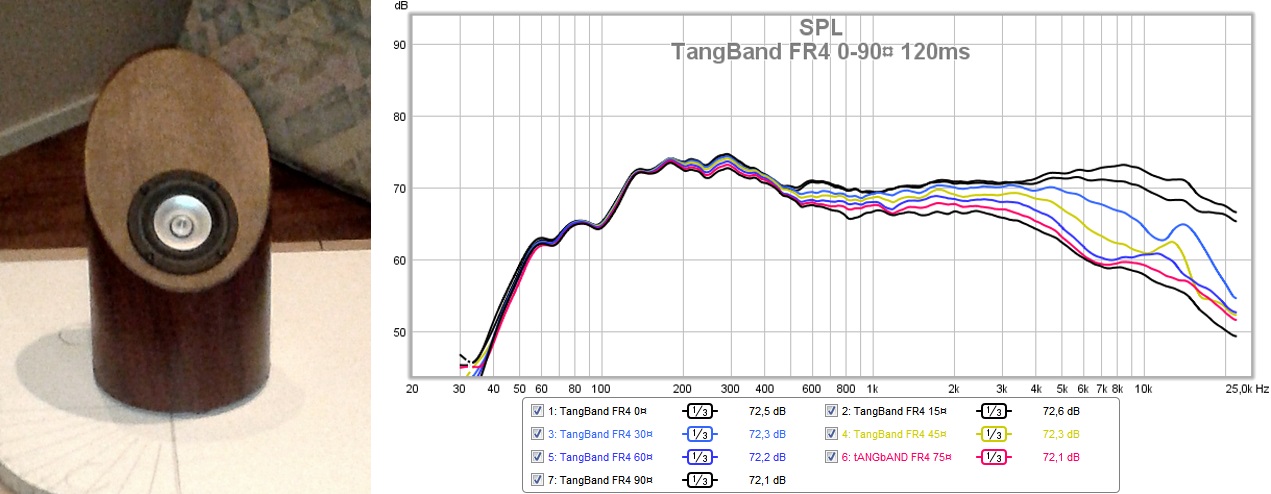
And here is a rather good 2-way computer speaker
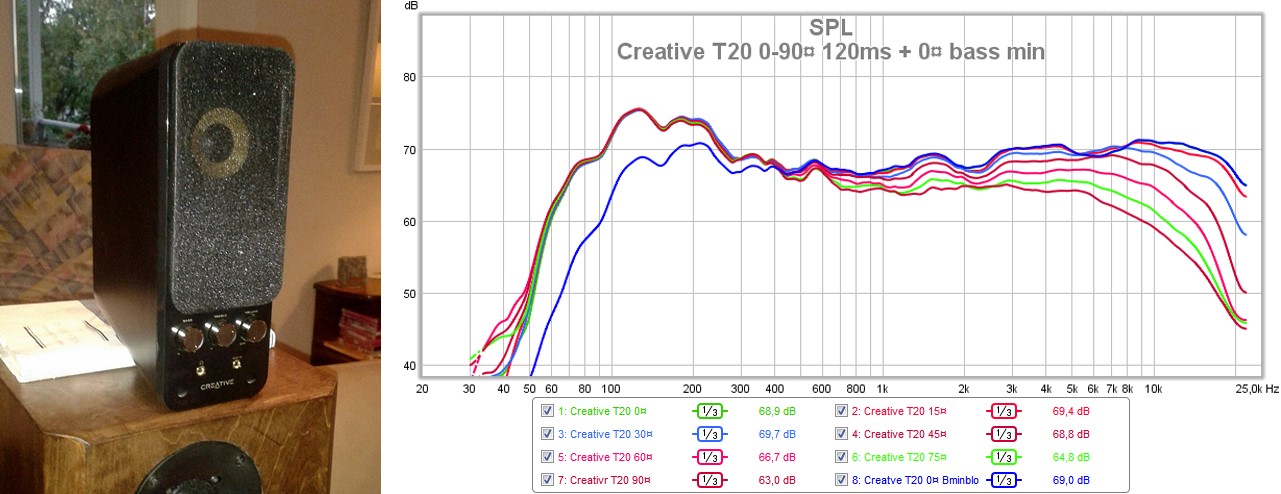
Because of physics every driver has hig-end roll-off. Some have been made to have an on-axis peak there to make power response better. This kind of drivers are not suited for nearfield!
Here is 0-90¤ directivity of my TangBand 3-871 (outer frame 4") Measured at 1m, IR gating 120ms to show bass response. Speaker on a stand. TB does not have on-axis peak but notice difference at 10kHz 30¤ (blue line) to a ½" dome of Creative T20.
I have measured these also on-table and it makes up to +/-6dB deviations.

And here is a rather good 2-way computer speaker

Last edited:
planet10, can you show off-axis measurements? Is that a 4" driver?
No measures by me. Ryan did some http://www.diyaudio.com/forums/full...udio-alpair-6p-tested-against-each-other.html. These kinds of measures are useful, but it is akin to being an ocenographer and only paying attention to the surface of the ocean, ie only part of the story.
I can sit in front of one speaker and still get a decent image.
Driver is the 3" Fostex based FF85wKeN.
The TN W3-871 you have is well lauded but on the low end of hifi 3" -- althou one of the 1st small FRs to have an impact on the market. The ones i have were $10/pr.
dave
Yep, TB is a cheapo, but excellent value. Now thy have better ones too.
Fostex and Alpair are way better with bass too. Small fullrenges have a variety of cone profiles and dustcaps, phase plugs etc to help with high end. Also, the cabinet diffractions are important to make them smooth. Smoothness is a little overrated thing with these, but high/wide peaks and dips will be heard, just like high directivity. There is a big difference between MA ad FF that you linked.
Fostex and Alpair are way better with bass too. Small fullrenges have a variety of cone profiles and dustcaps, phase plugs etc to help with high end. Also, the cabinet diffractions are important to make them smooth. Smoothness is a little overrated thing with these, but high/wide peaks and dips will be heard, just like high directivity. There is a big difference between MA ad FF that you linked.
There is a big difference between MA ad FF that you linked.
Some comments on the sonics. http://www.diyaudio.com/forums/full-range/196061-3-driver-audition-fostex-mark-audio.html
dave
No measures by me. Ryan did some http://www.diyaudio.com/forums/full...udio-alpair-6p-tested-against-each-other.html. These kinds of measures are useful,***
And prove my point about sensitivity to head movements when listening very close to the speakers. Especially when they're splayed out wide (on the sides of the monitor) as many seem to do.
Thanks for the data.
I'm really liking these:
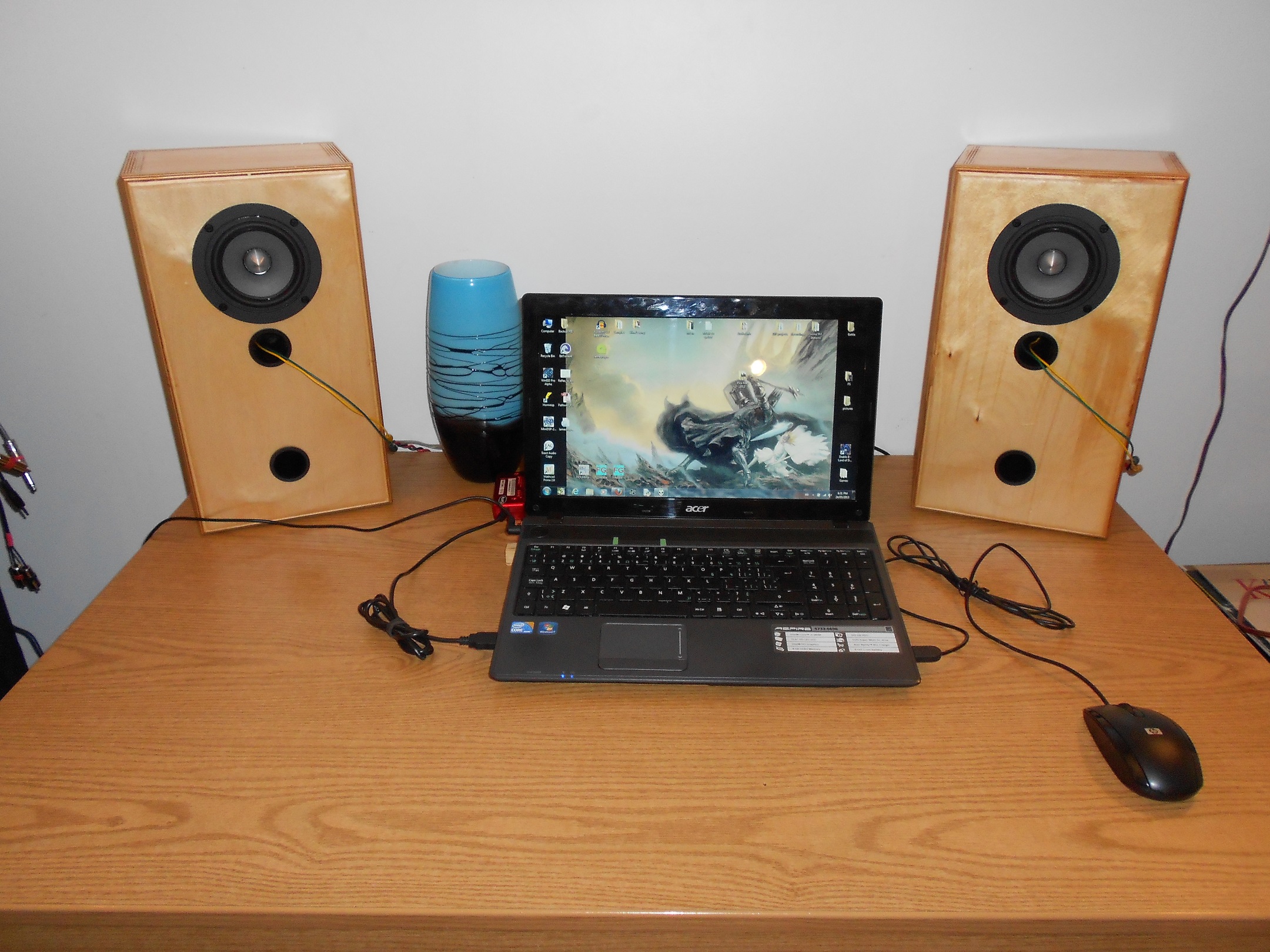
TB W4-1320SIF in DCR enclosures. Vb is a bit on the high-side to have a livelier bass, but it's nowhere near loose or boomy. I prefer to keep it somewhat tame with such quasi-quarter-space placement.
Nice bass and midrange, flat to 20kHz on-axis, but they do beam quite noticeably up there and presentation changes a lot with head movement. No BSC required with such placement.
On another desktop setup in my home, I'v been swapping various DIY creations for a few years now, not finding real satisfaction. Most of these were not all-out efforts though. I'm starting to think about a small two-way with miniDSP.
So some criterias of mine would be:
- Well-damped bass response considering the spatial loading
- Somewhat of a tilt in the HF power response, it can be ~flat on-axis, but avoid too much reflected power real high
- Point-source or the best approximation thereof if multi-way
I guess avoiding all desktop reflections will be hard since rather small drivers are usually involved.
IG

TB W4-1320SIF in DCR enclosures. Vb is a bit on the high-side to have a livelier bass, but it's nowhere near loose or boomy. I prefer to keep it somewhat tame with such quasi-quarter-space placement.
Nice bass and midrange, flat to 20kHz on-axis, but they do beam quite noticeably up there and presentation changes a lot with head movement. No BSC required with such placement.
On another desktop setup in my home, I'v been swapping various DIY creations for a few years now, not finding real satisfaction. Most of these were not all-out efforts though. I'm starting to think about a small two-way with miniDSP.
So some criterias of mine would be:
- Well-damped bass response considering the spatial loading
- Somewhat of a tilt in the HF power response, it can be ~flat on-axis, but avoid too much reflected power real high
- Point-source or the best approximation thereof if multi-way
I guess avoiding all desktop reflections will be hard since rather small drivers are usually involved.
IG
- Status
- Not open for further replies.
- Home
- Loudspeakers
- Multi-Way
- Desirable traits for nearfield/desktop setup
